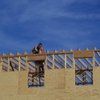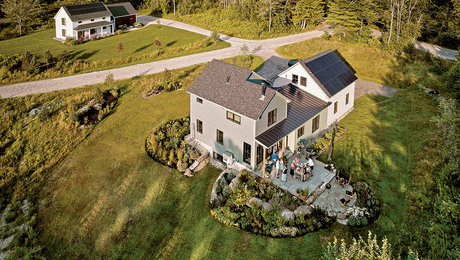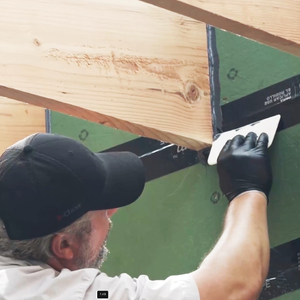How do bath vents work w/ sealed houses?

I’m considering having spray foam insulation installed in my house (2×6 exterior framing) rather than fiberglass bats (plans call for R-21 bats), anyway, I was wondering how this affects things like bathroom & dryer ventilation.
Since the venting causes negative pressure, air would need to be brought in from the outside, but with foam insulation, just about every crevice would be sealed – how is this handled (or are there still enough gaps throughout the house to let replacement air in). The biggest issue would be that if it couldn’t get replacement air, wouldn’t it begin to draw air from the furnace vent? I can’t imagine that would be good.


















Replies
You are correct in that if you ultra-seal the house, you will indeed need some form of fresh air exchange to both aid in venting and more importantly provide air for combustion in the HVAC system. While isolated furnace rooms can be built and still keep the rest of the house "sealed", I think you should consult with your HVAC designer to get the best solution for your house to avoid backdrafting and CO hazards. Many new homes are introducing fresh outside air using heat exchangers to minimize efficiency losses.
As you may know, most recent studies have shown that indoor air pollution is a very real issue in today's tight houses.
In short, as someone once said on this forum, do you want to live in a sealed thermos bottle? As for me, my 20 yr old house is plenty drafty so I rest easy knowing my HVAC bills have a slight premium added on to keep my air somewhat fresh.
You have to account for every consumer of air to prevent back drafting. Best solution here is to used sealed combustion appliances.
Fireplaces and woodstoves can also cause problems.
You can have your structure tested with a blower door.
A house sealed well enough would require an HRV (Heat Recovery Ventilator).
One of the things I toyed with in house plans I drew, but have not had the opportunity to actually try, is using several enclosed porches that are not sealed tight as heat/air exchangers. I even had one plan where I vented the clothes dryer and the bathroom fan to perferated pipes in gravel in a planter box with soil and plants over the gravel. These porches would also supply make up air through ducts near the ceiling. The entires were in porches as well, so every time you opened a door, you weren't flooding the house with unconditioned outside air.
re - is using several enclosed porches that are not sealed tight as heat/air exchangers.
-------This would be what is commonly known as an....airlock ?I am planning on enclosing our kitchen porch as well as the front entrance stoop to serve as airlocks and to remove soiled shoes, etc.
Yup, airlock is the right word--I was going to call it that, but didn't know if everyone would know what I meant. And the porches I propose would do more than just be an airlock.
re - And the porches I propose would do more than just be an airlock.
------Yes, likewise.Washer and dryer will move into the kitchen porch after it is enclosed, allowing laundry to be done on the main floor.
Will have to be done 'right' because it will also be a stepping out point to our pergola/patio area.
Sortof a combination airlock, mudroom, sitting area, and laundry combination.
Sounds good. I like the ability to take laundry outside to dry on a clothes line. Kind of hate to use gas dryer when the sun and wind will work!
What you have to do is put the HVAC and water heaters outside the sealed envelope. Use a more powerful fan in the bathroom, and just let it pull a slight vacuum on the whole house. Make sure all your entry doors are inswing, so you'll be able to open them. Stand clear, or the door will knock you on your tush when you open it. Install those drop down airline oxygen masks throughout the house, set to trigger automatically if somebody leaves the bathroom fan on too long. Make sure your engineer designs the shell of the structure for 14.7 PSI on all surfaces. ;-)
-- J.S.
Ia slo wonder about this issue. Bath fans don't worry me as much as clothes dryers. (Why the heck can't you buy a clothes dryer that draws in outside air?)
Bath fans are typically little wimpy things that don't move much air at all. But dryers can REALLY crank out the air.
When we built the house we're in now, the HVAC guy talked about rigging a 5" diameter pipe from the outdoors into the supply air duct. I guess that's kind of like a "redneck heat exchanger" or something. But we didn't end up doing it.
I wonder if it's a legitimate option, or not advisable?
If you've got a gas furnace it's required by code, or something equivalent. ("Equivalent" depends on the type of furnace, etc.)
--------------
No electrons were harmed in the making of this post.
>>When we built the house we're in now, the HVAC guy talked about rigging a 5" diameter pipe from the outdoors into the supply air duct. << >> I wonder if it's a legitimate option, or not advisable? <<
That's exactly what was done in the energy star certified homes I build back around 2001 - 2002. It was a 6" duct and it had a damper in it. As it turned out the damper was adjusted based on requirements of the system, and it ended up being so "choked down" that I argued with the guys administrating the program that a 6" was ridiculous since it ended up being ~90% (?) closed down. They later went to a 4" duct. In addition a system cycler was installed which was just a timer that made the HVAC sys blower come on at a programmed frequency and duration. One would think this would be a big waste of energy however these houses came with a written guarantee for energy usage which was an given as a dollar figure above the "base load" which was determined by average energy usage during the low usage months - say April - may and Sept - Oct. One of the guarantees had a figure of $27/mo for a ~1150 sq ft house. Keep in mind that our weather here in NC is a little more temperate than some of the northern and probably far southern locations in the US, and especially Canada. One small problem with this system was that it required a separate filter on the air induction pipe - same as a furnace filter only smaller which was just another maintenance item for the homeowner to ignore. These houses were all tested for duct leakage (I think 1 or 1.5% was the criteria) and building envelope leakage was tested using a blower door.
In a well sealed house, you must provide for make-up air for all exhausts. Consider installing a Heat Recovery Vent with the "Lifebreath" models. Or go simple, with something called a "sweedish vent", which is simply a hole in the exterior wall with a flapper valve, to allow incomming make-up air.
Whatever you use, pay particular attention to your combustion appliances, like furnace or water heater, to avoid back drafts.
You can buy the air vents with fabric dampers that allow incoming air under low pressure circumstances from http://www.efi.org.
Andy Engel
Senior editor, Fine Woodworking magazine
Never try to teach a pig to sing. It wastes your time and annoys the pig.
Other people can talk about how to expand the destiny of mankind. I just want to talk about how to fix a motorcycle. I think that what I have to say has more lasting value. --Robert M. Pirsig
None of this matters in geological time.
Or go simple, with something called a "sweedish vent", which is simply a hole in the exterior wall with a flapper valve
Aren't those things called Dog Doors?
Joe H
If you have a DOG door, it would sure make a great sweedish vent. A little big though, if the door was for a German Sheppard!
Habitat encourages very tight houses in their new generation of energy efficient (lowest cost of ownership over the long term) homes and has a lot of experience with the effects of tight houses and ventilation. At first it looked like air exchangers would be required, but experience showed that all windows and doors leak enough air to insure proper ventilation via bathroom and kitchen vents. To prevent stale air Panasonic (quiet) dual-use fans are used in place of air exchangers (continuous run at a slow speed and high speed for normal on/off use).
The furnace and hot water heater are placed in a sealed mechanical room with outside incoming air vents allowing proper exhaust. The mechanical rooms have exterior doors for insulation/sealing purposes at the entrance and the walls are insulated. However, the exterior wall is also insulated and the mechanical room stays well above freezing, although not heated per say.
I found it enlightening that some of the best energy efficient ideas are being used by Habitat.
:-)
RE backdrafting, this can be prevented by using direct vent water heater, etc, or by using a gas pack which is essentially a furnace that is installed outside.
Also, I had a discussion with a HVAC guy a week or 2 ago. Apparently the new (national?) mechanical code has a requirement for makeup air. In some houses built by my company, this was accomplished by installing a air induction duct into the washer dryer room that brought in outside air. Apparently modern dryers move more air than their predecessors. Seems like it would be a big waste of energy but who knows... As far as the code, I don't know hardly squat about mechanical code, and it may also be something that NC added to a generic code book.
Really though, a HRV (heat recovery ventilator) or ERV (Energy recovery ventilator - does both heat and AC) is the answer (in addition to better aspiration techniques for any fuel burning appliances. These HRV/ERVs can get pricey though, and last I checked - probably 5 years ago, it was felt that they would not pay for themselves in a reasonable period of time in the mild climate I live in - NC. They are definitely more feasible in cold climates like Canada. I believe I remember reading here that they are required by (some?) Canadian residential mechanical codes. I do believe that HRV or ERVs are required by most all commercial mechanical codes.
http://www.toolbase.org/techinv/techDetails.aspx?technologyID=122
If anyone has any info on current HRV/ERV pricing I'd like to hear about especially in relation to requirements per house size.
In short it's all about indoor air quality which can be a significant concern in today's tight houses. It probably wasn't even a concept back 100 years ago when the wind literally blew through people's homes.
Edited 10/14/2005 9:00 pm ET by Matt
I have gone the air-tight approach with HRVs and it sure is expensive, but it made sense in a really cold climate with high energy costs. Now I live in a much warmer region with lower energy costs. I still try to build as air tight as possible, just don't kill myself takeing it to anywhere the extreme I used to.
I am going to try an idea I read about in JLC (Ithink) on the home I am currently building. Put in a 4"make -up air vent directly beind the refrigerator. Fridge gets cool air and the cool air gets a little "free" prewarming before getiing into the true living space.